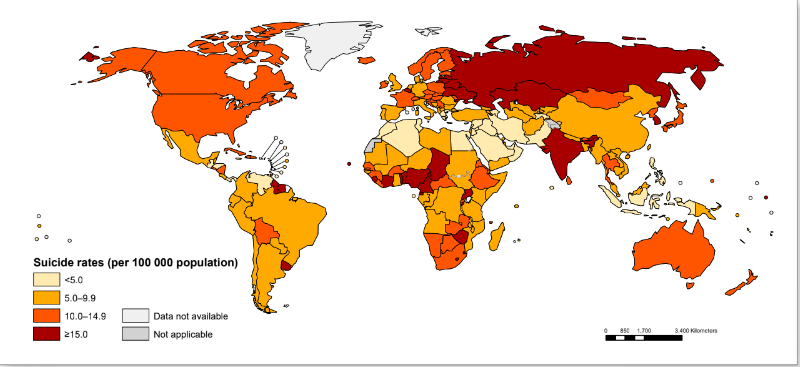
In 2018, celebrity chef Anthony Bourdain used one of the most common methods to commit suicide by hanging himself at a hotel in France. The incident ignited debate on preventive measures in place to stop such deaths. But pesticides, the second most widely-used way for suicides in developing countries, evaded global attention.
Nearly a year after the incident, despite countries making efforts to formulate national suicide prevention strategies, action to prevent such deaths remains inadequate.
Only 38 countries have implemented policies to stop people from taking their own life, according to a study released by the World Health Organization (WHO) on Monday, to mark the eve of World Suicide Prevention Day.
Even high-income countries have failed to act, resulting in the highest rate of suicide at 11.5 per 100,000 people. "Despite progress, one person still dies every 40 seconds from suicide," said WHO director-general, Dr. Tedros Adhanom Ghebreyesus.
The situation has turned alarming in low and middle-income countries that are home to 84 percent of the global population, witnessing 79 percent of total global suicides.
Ban pesticides
With pesticide self-poisoning and firearms emerging as the second most-preferred mode for suicides, the government must act urgently on the issue, the study titled Preventing Suicide: A Resource for Pesticide Registrars and Regulators suggested.
In recent years, self-poisoning with pesticides has caused up to one in five of the world's suicides. Concerned over the high toxicity of pesticides that have a limited number of antidotes, the WHO is seeking governments' intervention to regulate the chemical, used widely for farming, to prevent suicides.
"There is now a growing body of international evidence indicating that regulations to prohibit the use of highly-hazardous pesticides can lead to reductions in national suicide rates," revealed WHO's study.

Global suicide rate per 100,000 persons, based on a study conducted in 2016. /WHO Graphics
The WHO cited the example of Sri Lanka – best-studied country for pesticide use – where a series of bans led to a 70-percent fall in suicides and an estimated 93,000 lives saved between 1995 and 2015.
Paraquat, an herbicide wreaked havoc in the Republic of Korea accounting for the majority of pesticide suicide deaths in the 2000s.
A ban on the product in 2011-2012 nearly halved the number of suicide deaths from pesticide poisoning between 2011 and 2013. The study found no evidence that such bans were adversely affecting the crop yields.
"Every death is a tragedy for family, friends, and colleagues. Yet suicides are preventable. We call on all countries to incorporate proven suicide prevention strategies into national health and education programs in a sustainable way," Ghebreyesus added.
Young lives lost
Among young people aged 15-29, suicide emerged as the second leading cause of death, after road injury.
Suicide was the third leading cause of death among teenagers, 15-19, for both sexes, with the number of fatalities relatively similar between males and females in this age group.
For teenage girls, suicide was the second leading cause of death, after maternal conditions and the third leading cause of death in boys, after road injury and interpersonal violence.
Nearly 90 percent of the adolescent suicides were found in low- and middle-income countries.
More than half – 52.1 percent – of the global suicides occurred before the age of 45.

Copyright © 2018 CGTN. Beijing ICP prepared NO.16065310-3
Copyright © 2018 CGTN. Beijing ICP prepared NO.16065310-3